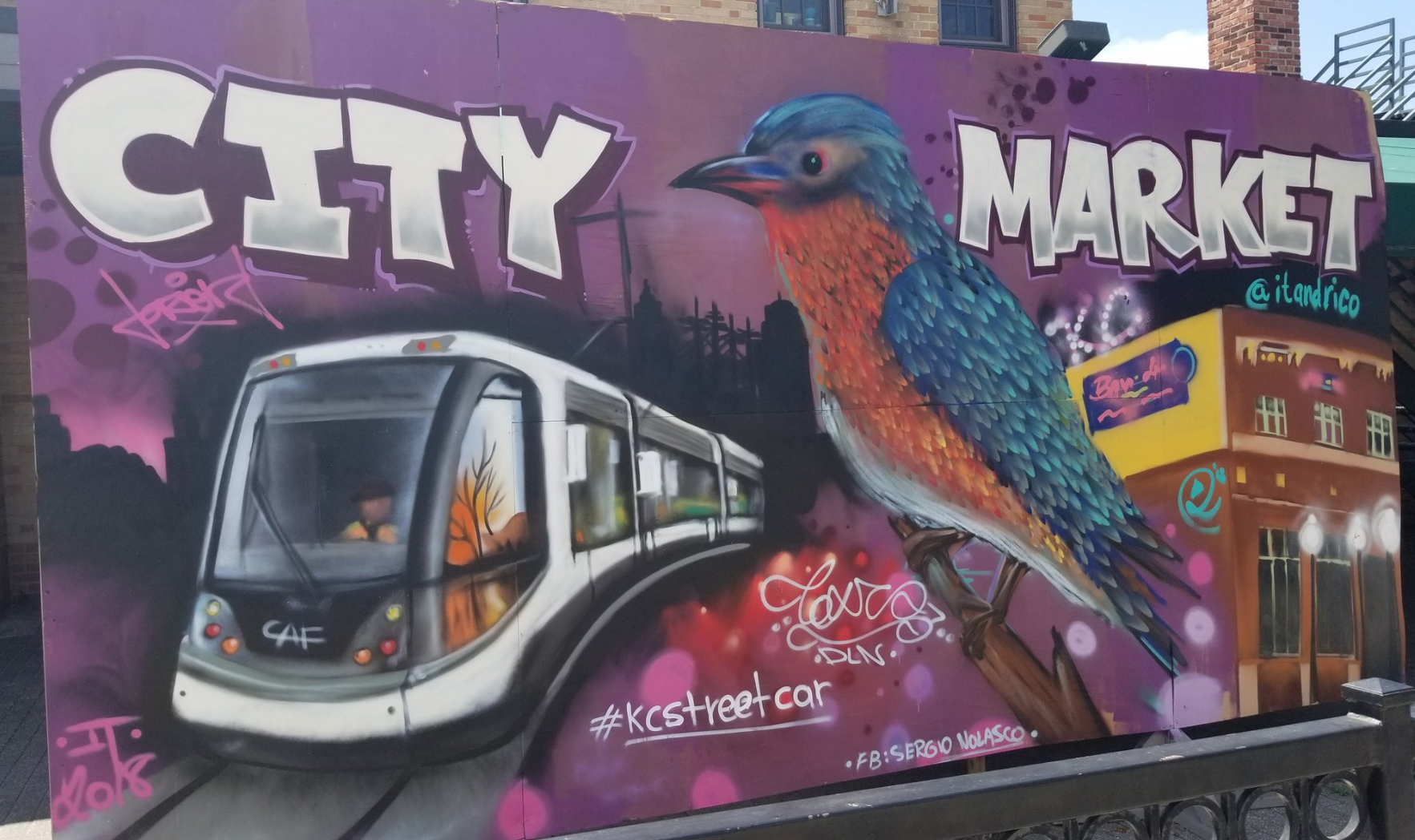 During a recent briefing on Capitol Hill, a panel of different stakeholders including the mayor of Kansas City spoke about the important national impacts that local transit investments have. While the mayor was in Washington, DC, Erika Young from Smart Growth America took a trip to Kansas City to see the local impacts of the KC Streetcar.
During a recent briefing on Capitol Hill, a panel of different stakeholders including the mayor of Kansas City spoke about the important national impacts that local transit investments have. While the mayor was in Washington, DC, Erika Young from Smart Growth America took a trip to Kansas City to see the local impacts of the KC Streetcar.
Cities, states, and the federal government all have a stake in building a stronger, more resilient economy. It’s in pursuit of that goal that local and federal governments have partnered, pooling resources to build public transit systems across the country. These buses, trains, and ferries help spur local investment, support high-paying jobs around the country, and provide the foundation for robust regional, state, and national economies. Localities invest their own dollars, often raised through local taxes, expecting a reliable federal partner. They do so because, without transit, our nation’s economy would suffer. Everyone—locals, states, and the federal government—need to be at the table investing, together, in these important transportation systems; one entity can’t go it alone.
That’s the case with Kansas City, MO. In recent years, the city created new a ‘Transportation Development District’ to raise local funds for a streetcar, and used additional federal and state funding to build it. Known as the KC Streetcar, the line has spurred hundreds of millions of dollars of investment while supporting manufacturing jobs across the country. Recently, Kansas City Mayor Sly James came to Washington, DC to talk about the value of federal transit investments and their national impact with a panel of other stakeholders—a regional chamber of commerce, transit manufacturer, and transit agency. While Mayor James was on Capitol Hill making the economic case for transit, Smart Growth America’s Director of Strategic Partnerships, Erika Young, visited Kansas City to see the local impact first hand.
On the ground in Kansas City, MO
Long before the trains started rolling down the street, the Kansas City made extensive changes to the area around the Streetcar. They selected the route, augmented zoning around the line to allow more development, implemented fees for surface parking lots, and removed parking requirements for new homes and businesses. A special tax district was also implemented to capture some of the increased sales and property values that would occur due to the line and provide an ongoing funding source (more on that in this podcast). The city also received federal grants to help round out the funding for the KC Streetcar. All this upfront work set the stage for what happened next.
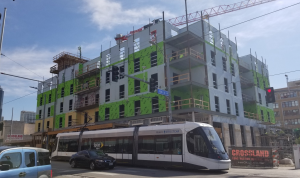
A new hotel under construction along the KC Streetcar route. (Image: Staff)
Magic. While the streetcar has only been up and running for a little over two years, it has transformed downtown with new hotels, businesses, and residences. The streetcar and the mobility and connections it provides—as is often the case with quality transit—were enough to spur this new development. While hundreds of millions of dollars have already been invested in new development along the line, as Erika learned, there’s even more construction planned. Surface parking lots are being transformed into economically productive places. Sixty percent of the riders on the streetcar ride it for work. This isn’t a fluke or an aberration. This streetcar and transit more broadly, is an important component to creating strong economies. While the local impacts of the streetcar are easy to see, the KC Streetcar has had national impacts on economies which are largely unseen, but no less important.
While Erika was on the ground in Kansas City (#SGAinKCMO), Kansas City’s mayor was back in Washington, DC talking about those economic impacts.
Meanwhile, on Capitol Hill…
Kansas City, MO Mayor Sly James joined a panel of business and transit professionals from around the country organized by Transportation for America to brief Congress members and their staff about the effects of federal transit investments. The panel included Alesha Washington from the Great Lakes Metro Chambers Coalition; Don Makarius from Kiel North America (a manufacturer of seats for public transit); and Bill Van Meter, Assistant General Manager of Planning at the Denver Regional Transportation District (RTD).
Even with their diverse backgrounds the panel spoke unanimously about the importance of federal funding that makes transit projects possible. Without a federal partner, public transit projects would stall, preventing cities and regions from realizing new private investments and affordable transportation options while starving transit manufacturers around the country of critical business opportunities.
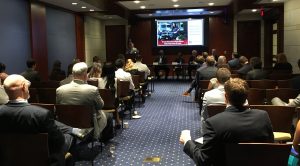
Transportation for America’s Congressional briefing in the Capitol Building. (Image: Staff)
The Kansas City Streetcar, for example, received $37 million in federal grants. Mayor James, who championed the project throughout its planning and construction, emphasized that without a strong partnership with the federal government, Kansas City wouldn’t have achieved the level of success that it has seen along the streetcar route. The same is true for RTD in Denver where five of the past 11 major corridor projects in the area have received federal funding, according to panelist Bill Van Meter, who oversees project development at RTD.
The local and regional investments in public transit seen in Denver and Kansas City ripple outward to other cities and states through transit manufacturers like Kiel. Take RTD’s $678 million W light rail line, for which the agency received $308 million in federal New Starts funding, part of the Capital Investment Grant (CIG) program. As Van Meter explained, the agency spent almost $500 million on acquiring transit parts, materials, and supplies that were sourced from outside of Colorado. Businesses in 16 states produced everything from fiber optic cables to station furnishings.
For businesses that make parts for public transit systems, federal funding for transit projects ensures a regular, predictable stream of business that supports high-paying manufacturing jobs. At Kiel North America—headquartered in Elkhart, IN—almost 80 percent of their clients are public transit agencies receiving federal funding for their transit projects. Don Makarius, Kiel’s assistant chief operations officer, sees a clear connection between federal investment in transit and the long-term health of his business: “Without the federal funding that keeps cities’ public transit projects alive, we probably won’t be here long term.” The pipeline of transit projects in various stages of development awaiting federal grants includes approximately 50 projects in 19 states.
But the impact of the public transit supply chain goes beyond individual companies to affect entire regions. The Great Lakes region for example boasts more than 1,000 transit suppliers and manufacturers. “Strong federal investments in transportation are critical to economic success of the Great Lakes,” according to Alesha Washington from the Great Lakes Metro Chambers Coalition (a group of chambers from eight states). National public transportation investments are a big part of how the Great Lakes region will continue to grow and thrive.
 From left to right: John Robert Smith, Transportation for America (moderator); Kansas City Mayor Sly James; Alesha Washington, Great Lakes Metro Chambers Coalition; Don Makarius, Kiel North America; Bill Van Meter, RTD (Image: Staff)
From left to right: John Robert Smith, Transportation for America (moderator); Kansas City Mayor Sly James; Alesha Washington, Great Lakes Metro Chambers Coalition; Don Makarius, Kiel North America; Bill Van Meter, RTD (Image: Staff)
Transit manufacturing businesses, the jobs they support, the local transit investments being made across the country, and the economies they contribute too, all feed back into our national story. A strong Kansas City economy contributes to strong regional and state economies which in turn contribute to the national economy. As Mayor James noted, “if the idea is to have a vital vibrant economy, we have to produce jobs that people can get to, and public transportation is vital to that process.”
While the Trump administration has proposed eliminating critical sources of federal transit funding—like the BUILD Grants program (formerly known as TIGER) and the CIG program—and dramatically cutting other programs, Congress has so far rejected those proposals. We join our panelists in thanking members of Congress who have supported these programs, and will continue working to ensure that the federal government remains a strong partner with states and local governments as we build more transit.
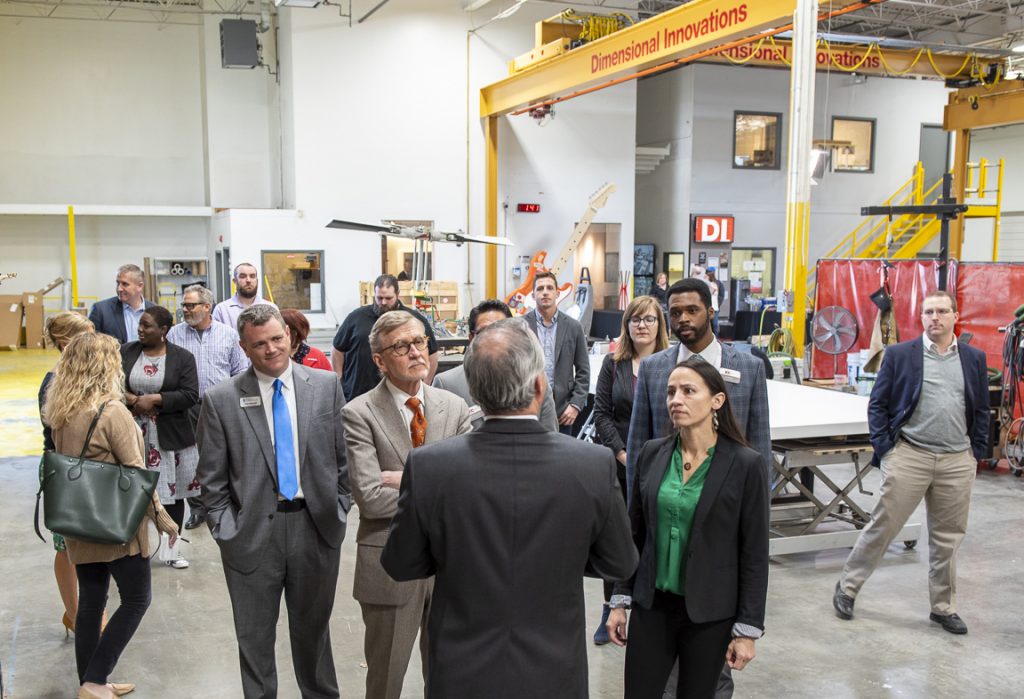
 Last month Transportation for America’s Chairman John Robert Smith traveled to Overland Park, KS to discuss the economic impact of public transportation dollars on local manufacturing jobs with state and local leaders. Local manufacturer Dimensional Innovations (DI) hosted the event at their facility where attendees saw the recently constructed shelters destined for the Downtown Kansas City Streetcar. Transit shelters are one part of the transit supply chain with over 20 percent of DI’s business stemming from public transportation.
Last month Transportation for America’s Chairman John Robert Smith traveled to Overland Park, KS to discuss the economic impact of public transportation dollars on local manufacturing jobs with state and local leaders. Local manufacturer Dimensional Innovations (DI) hosted the event at their facility where attendees saw the recently constructed shelters destined for the Downtown Kansas City Streetcar. Transit shelters are one part of the transit supply chain with over 20 percent of DI’s business stemming from public transportation.
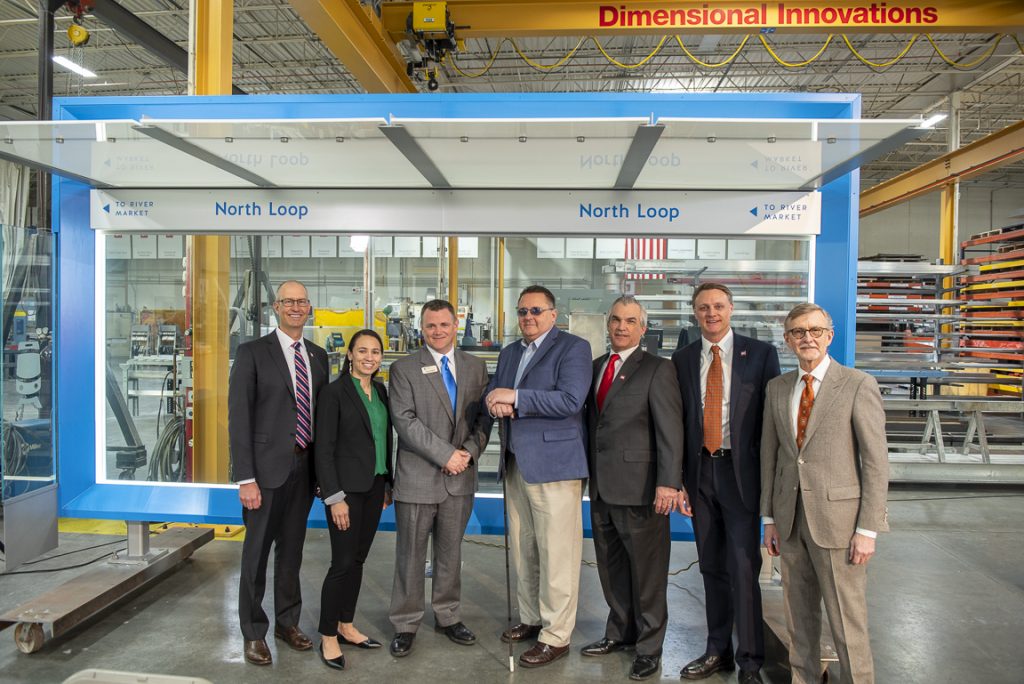
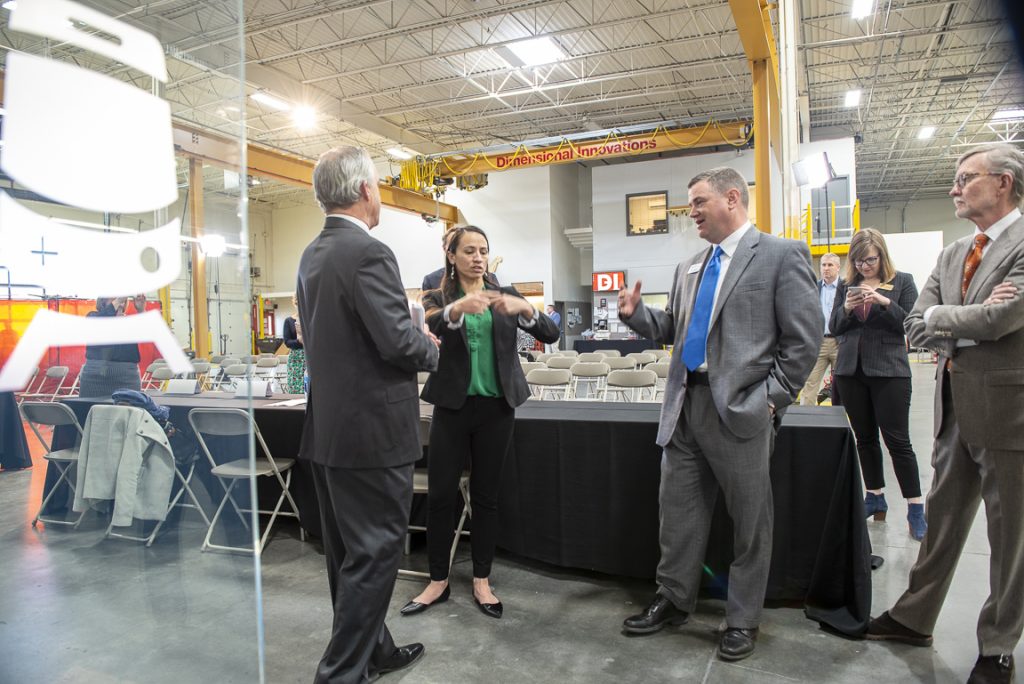




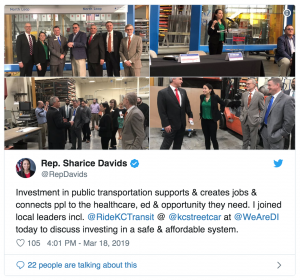
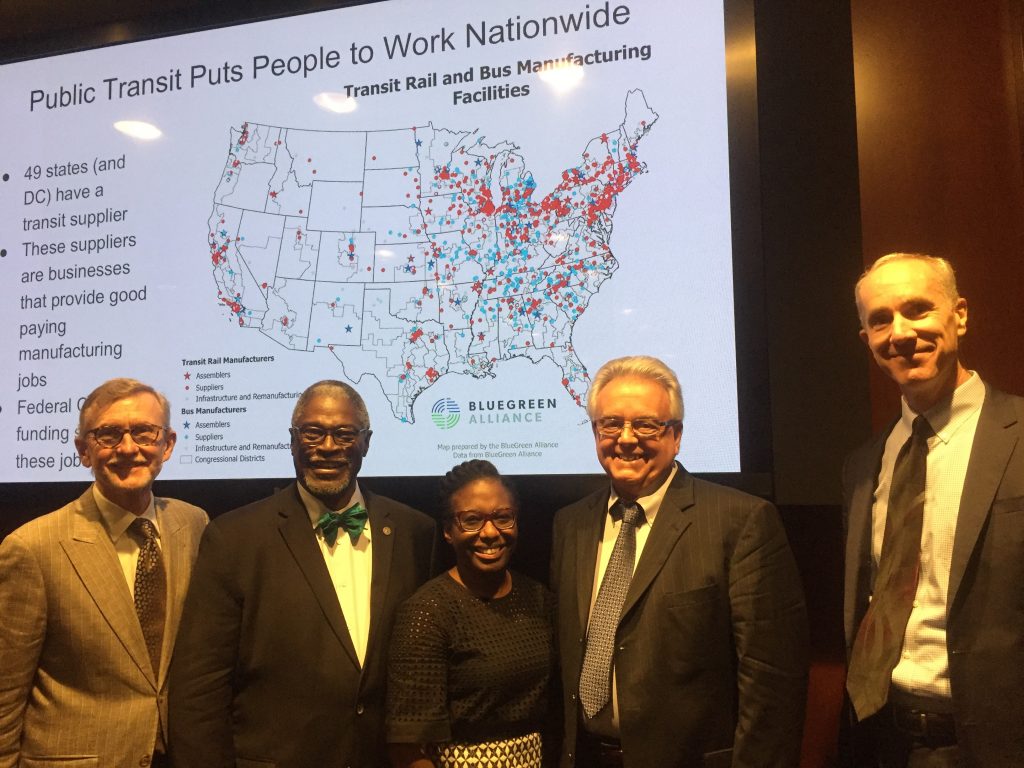
 During a recent briefing on Capitol Hill, a panel of different stakeholders including the mayor of Kansas City spoke about the important national impacts that local transit investments have. While the mayor was in Washington, DC, Erika Young from Smart Growth America took a trip to Kansas City to see the local impacts of the KC Streetcar.
During a recent briefing on Capitol Hill, a panel of different stakeholders including the mayor of Kansas City spoke about the important national impacts that local transit investments have. While the mayor was in Washington, DC, Erika Young from Smart Growth America took a trip to Kansas City to see the local impacts of the KC Streetcar.

